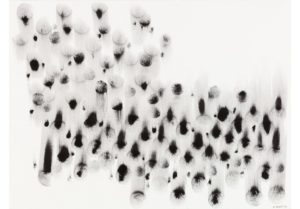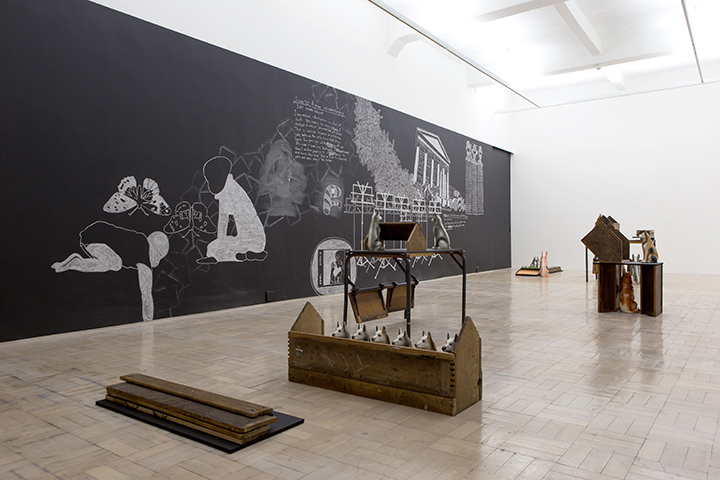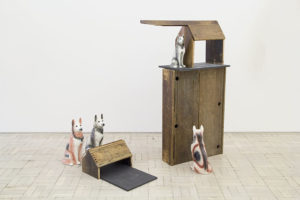
Themba Tsotsi writes about the work of the South-African artist Kemang Wa Lehulere. Starting point are two exhibitions of Wa Lehulere at Stevenson Gallery in Cape Town: Here I am, a concrete man throwing himself into abstraction (2017) and To whom it may concern (2015).
I was never here (black out), detail, 2018.
Kemang Wa Lehulere
Concrete in Abstraction
Stevenson Gallery in Cape Town is hosting visual artist Kemang Wa Lehulere’s exhibition titled Here I am, a concrete man, throwing himself into abstraction. The exhibition is filled with works that see the artist engaging in visual representations that are elliptical and truncated. The works are barren of the measure of pathos that his usually symbolic works operate with. Rather the works operate with a measure of the relational and controlled. The collection of works is comprised of works that see the artist being experimental with drawing, by placing it in relation to installation, attempts to articulate what is concrete about his work. The exhibition features the characteristic porcelain dogs, which have become a feature of Wa Lehurele’s work; the exhibition explores his existential modality in terms of how his background influenced him.

I was never here (black out), 2018.
The exhibition resounds with a nostalgia that is often implicit in Wa Lehulere’s work, in this exhibition it operates to concretize the images or blotches of nostalgia that affect the artist and render frail and intelligible the symbolic and aesthetic role of the porcelain dogs. This can be discerned in how some of the dogs are broken, their heads off, some are isolated or placed in locations where their solitude is pronounced. The exhibition discourses coming of age in a manner that is about relinquishing and being tethered. This is significant in not only how there is an installation with the dogs tied to metal, but the blotches on the paper articulate the measure that renders them relational, the artist is discoursing the frailty of the connections he has about his background, his home and his father.

Retrograde Shower 2, 2017.
This is reflected in the piece titled Retrograde Shower 2, ink blotches rain down on the paper creating imprints of themselves in a dripping effect. This way the works assume a terse impact without being sparse or random even. Form and formlessness assume an interrelation aspect within the work and in relation to other works creates an effect of continuity and completion. The effect of retraction or retrogression can be discerned in how the works operate with a measure of movement and status. In Retrograde Shower 2 for example the blotches rain down on the paper, not only does this effect imply exhaustion, it also symbolizes a sense of replenishment on the part of the artist in relation to how he feels about coming of age.
The title of the exhibition is supposedly taken from the artist’s father’s journal. Themes of coming of age can be discerned in the title, but assume a different stance in relation to the pedagogical implication of the deconstructed desk stands and the nurture and nostalgia that is implied by the porcelain dogs. The artist discourses the location he is in his life through his comprehension of aesthetic from social background and how he was nurtured through it and the implications of coming of age and its ephemeral connotations.

Detention 3 (Bad Boy), 2017.
With some of the titles in the exhibition demonstrating discourse with the pedagogical, the artist is at a stage in which he is discoursing an intersectionality of affects, aesthetic discourse and attitudes towards his relationship with family. This confluence of discourse is not represented in a measure that is clustered or conflicted; rather the sparse measure with which he represents his effect through the ink blotches demonstrates clarity of discourse and a measure of coming of age that is about abstraction when one comprehends its implications and justifications. This confluence of discourse is reflected in the piece titled Detention 3 (Bad Boy) a piece in which the materials that comprise the works in the exhibition have found object principle about them. Deconstructed wood desk back rests drilled with holes and connected with shoe laces on the wall with three pieces of wood tethered to a glass bottle on top of deconstructed drinks crate and gold painted porcelain dog. The necessity for separating elements forces the artist to demonstrate their proximity in the visceral and existential measure of his individual modality. This way if the exhibition is about relinquishing what is affective about his existential development, then it can be demonstrated through this art work that it is immediate to him, if it is about intellectual comprehension of an aesthetic, then it can be demonstrated for its individual historic implications through the exhibition. The piece’s pedagogical title highlights the measure with which being conscious of one’s subject enables the artist to imbue the art work with a measure of insubstantiality both in terms of the structure of the works and in terms of the measure of movement that is implicit in the works.

To whom it may concern, installation view, 2015, Stevenson Gallery, Cape Town.

My apologies to time, 2015.

Dear Shioko Omi, 2015.
In another presentation with the Stevenson Gallery titled To whom it may concern the artist created an exhibition in which his existential modality also had an abstract and visceral role, utilizing the Fluxus Movement’s strategy of the found object with the title of the installations: My apologies to time and Dear Shieko Omi. The installation Dear Shioko Omi is comprised of porcelain dolls, school desks, black board surfaces with chalk drawings that depict a narrative or ‘unfinished drama’ that is both symbolic and literal, with the Fluxus spirit of minimalism and the avant-garde. Just like in the Fluxus movement the ‘found’ object in the installation becomes barren of its lack luster status and usurps its environment an atmosphere that is both playful and poignant. Consistent with the Fluxus’ movement’s incorporating space and the immediate environment into operation of the art work, so that the work operates like a hub or a conduit between the audience and the piece, between the piece and the object itself, but also between the object and its immediate atmosphere. This not only functions to imbue the piece with a measure of poise that is reserved only for itself, but also a measure of poise that the audience can engage with. For example the use of the porcelain dolls renders the installation with the poignancy and contrived nostalgia of ‘home’ that the presence of the desks can demonstrate is not just about domesticity but the measure of the incomplete that learning can induce in the individual and the audience. It is an installation that is consistent with the notion of attitude that connotes an aesthetic about coming of age and perhaps the artist’s psycho-social background.
In Here I am the ambiguity of completion and lack of completion is discoursed through the sense of nostalgia and realization of coming of age that permeates the exhibition. The artist’s existential modality is also imbued with the quiet pathos and energy that usually characterizes the artists works, in this exhibition beginning points become realized or completed, in To whom it may concern there are myriad of starting points, this did not render it convoluted, but like Here I am it was an exhibition about a modality of affective independence and aesthetic exploration.
When Wa Lahulere started with experimenting with installation in his work, the sense of pathos and its relationship with his modality became pronounced. This was achieved in the exhibition To whom it may concern through incorporating an ‘incomplete’ narrative or play about Nat Nakasa, a piece that was symbolic of an emancipated modality and how it can limit itself and eventually thwart its own creativity. In Here I am this emancipated modality and how it operates is achieved through the deconstruction of material, this pronouncing their symbolic operation in relation to their aesthetic operation, it also pronounces the measure with which what is pedagogical operates as an emancipatory element.

Detention 1, 2018.
In Here I am there is no sense of drama or tension between the installation and the atmosphere or environment in which it is curated. This way the works assume a truncated aspect without being minimalist and imbalanced in terms of the elements that comprise the exhibition in its entirety. This is reflected in the installation titled Detention 1, a piece comprised of black and gold painted porcelain dog dolls standing next to deconstructed school desk metal stands. Volume and space become imbued with a symbiotic relationship, there by extending and mineralizing the operation of space. The laced desk back rests on the wall operate with this implication of extending space; they also imbue the piece with the measure of scale in terms of the internal relations the elements in the piece create with each other. The dogs are not symbolic spectators if you will; they are also symbolic of an internal modality and auto reflection that imbues the piece with the existential pathos that characterizes Wa Lehulere’s work.
In the installation pieces the porcelain dogs provide this sense of implied nostalgia, in the piece titled Detention 3 (Bad Boy) this nostalgia can also be discerned for it being tethered to what is pedagogical in the exhibition.
In a way the exhibition is also the artist discoursing his comprehension of existential or individual independence. The reference to childhood games is reference to being conscious of this freedom that is implicitly operational when coming of age. In the interstices of this exhibition the impact that childhood games confer on an individual can also be detected for their ephemeral and long term impact. In that as an artist he is able to demonstrate what was benign about them through the nostalgic energy that permeates the exhibition, but also through the spaces between objects and drawings in a measure that is symbolic.

Matric 2015.
What is fresh about this exhibition is that it is not about escapism, or the quiet and honest brutality of a thwarted childhood, rather it implicitly and abstractly demonstrates the extent of self defined freedom while coming of age. That even if one has inclinations for delinquency, they are auto-formative strategies self imposed. This is reflected in the title of the main installation in the exhibition titled Matric 2015. It is another piece with a confluence of the show’s materials combining to articulate this immediate nostalgia that characterizes Wa Lehulere’s works. Deconstructed desks, black painted porcelain dolls and glass bottles with sand in them. The irony of the empty glass bottles also imbues the discourse of nostalgia and being conscious of coming in age with the implications of an ambiguity of presence and absence. That they communicate that time and the concept of the time capsule combine to articulate phases and grades in the process of coming of age, but not historic truths. This way what is personal can be discoursed for its historic implications and what is affective can be discoursed for its ambiguity of immediacy and reflection.
Unlike the exhibition To whom it may concern, Here I am is not imbued with a sense of poignancy in the interstices’ of the exhibition. This would imbue the retrospective and retrograde operation of themes of the exhibition with a modality of dependency on what is historic, rather Here I am resounds with a nostalgia, this way its modality is consistent with this emancipated aspect, it is also consistent with implicit operation of relinquishing particular existential aspects of coming of age.
